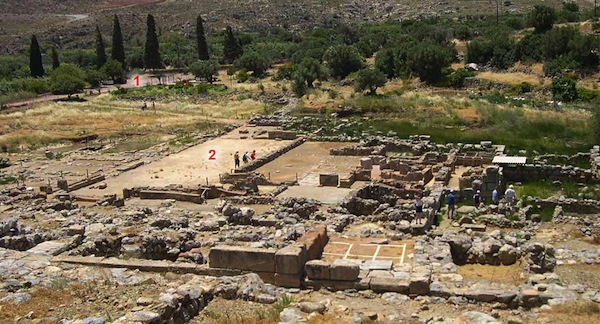Minoan civilisation, Zakros Palace in particular, are the focus of the 11th International Cretological Congress on October 21-27 in Rethymnon, one of the three big cities on the island. The Minoan Zakros Palace, located on the eastern part of the island, is one of the four Minoan palaces – the others are Knossos, Festos and Malia – uncovered by archaeological excavations last century.
The palace spans 4,500 square metres (one fifth of the area of the Palace of Knossos) and was the religious and administrative centre for a settlement that spanned 8,000 square metres. The palace has two main structures, built over 2 different periods. The first was constructed around 1900 BC (during the same period as the Palace of Knossos) and the more recent construction is from around the year 1600 BC. The palace was destroyed, along with the other settlements on the island, in 1450 BC by a catastrophic earthquake almost certainly followed by a tsunami and was not rebuilt.
The first archaeological excavations in Zakros, which began in the year 1900 and were carried out by the English Archaeological School, uncovered about 10 houses from the Late Minoan period and many interesting ceramic fragments, copper items from the prehistoric period and others, considered to be among the most important discoveries on Minoan civilisation.
During WWII, excavations stopped and were not resumed until 1961 by Greek archaeologist Nikolaos Platon, and they are still continuing today. During the Congress in Rethymnon, Lefteris Platon, Nikolaos’ son, will present studies carried out on the ruins which show how the construction of Zakros Palace, after the natural disaster in 1450 that destroyed all Minoan-era buildings in Crete, marks a radical change in the political and economic character of the site.
“Recent restoration work and studies on the archaeological material from Zakros Palace,” said Lefteris Platon, “come in addition to several new and particularly interesting finds that we think are related to a goal to transport the political and ideological concept of Knossos in the heart of the local Minoan community.” “The construction of this palace,” continued the archaeologist, “was an integral part of a large project to extend the influence of Knossos during that period to several strategic points of Minoan sovereignty.
Several of the symbols that appear at different Minoan sites in the area were created at Knossos and were used as propaganda for its political and ideological domination in the development of the Minoan world.” Over 600 reports will be presented at the Congress, which scholars and researchers from across the world will use to explain the most recent finds on the history and culture of Crete.
See all the latest news from Greece and the world at Greekreporter.com. Contact our newsroom to report an update or send your story, photos and videos. Follow GR on Google News and subscribe here to our daily email!




